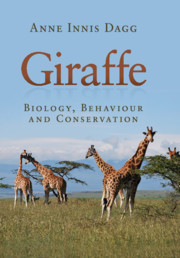Book contents
- Frontmatter
- Dedication
- Contents
- Preface
- Acknowledgements
- List of abbreviations
- 1 Time-line of giraffe
- 2 The giraffe’s environment
- 3 Feeding in the wild
- 4 Social behaviour and populations
- 5 Individual behaviours
- 6 External features
- 7 Anatomy
- 8 Physiology
- 9 Pregnancy, growth, reproduction and aging
- 10 Giraffe in zoos
- 11 Status and conservation of giraffe races
- Appendix Parasites and pathogens
- References
- Index
6 - External features
Published online by Cambridge University Press: 05 February 2014
- Frontmatter
- Dedication
- Contents
- Preface
- Acknowledgements
- List of abbreviations
- 1 Time-line of giraffe
- 2 The giraffe’s environment
- 3 Feeding in the wild
- 4 Social behaviour and populations
- 5 Individual behaviours
- 6 External features
- 7 Anatomy
- 8 Physiology
- 9 Pregnancy, growth, reproduction and aging
- 10 Giraffe in zoos
- 11 Status and conservation of giraffe races
- Appendix Parasites and pathogens
- References
- Index
Summary
Size
Why is it great to be big and tall? Unlike other browsers, giraffe eat leaves growing near the ground, leaves 5.5 m (18.2 ft) above the ground and leaves everywhere in between; a large male measures about 4.5 m high in a normal standing posture, but it can add a metre to its height if it spies a tasty morsel by tilting its head back and extending its prehensile black tongue. Only elephants and arboreal species can forage so high. Because of their long legs giraffe can walk long distances in search of food or water. They can spot approaching danger sooner than can smaller animals, but have few predators anyway because of their size. This large size allows for efficient use of food, both in its storage and in its fermentation. It means they live a long time with the concomitant beneficial accumulation of experience and of antibodies against diseases. It enables them to keep cooler in hot weather than can small mammals which have to seek shade on scorching days: its elongate shape gives it large expanses of body surface from which internal heat can be dissipated. Giraffe prosper in hot climates without resorting to lolling in water or wet mud as do other heavy megaherbivores – hippos, elephants and rhinoceros. Over 5 months at the Taronga Zoo in Sydney, Australia, I made a note of which animals sought shaded areas on hot days (Dagg, 1970a). The giraffe was one of the few species which seemed impervious to the heat; only on the hottest day (54°C in the sun and 38°C in the shade) did most of the herd of 18 choose the shade. Even so, six animals remained in the sun.
Hide
The hide or skin of the giraffe has features related to their dermal armour, blood pressure and thermoregulation. To study these adaptations, Farzana Sathar, Ludo Badlangana and Paul Manger (2010) examined in detail the complete skin of one young male and confirmed their findings on the skins of two other males, one young and one adult. They found that the skin was often thick, measuring up to 20 mm, but that its thickness varied substantially across the body surface. The outer epidermis was very thin, overlying a thicker superficial dermis and a very thick deep dermis. Sweat glands (which are inactive) and larger blood vessels demarcated the two dermal layers, both composed mainly of collagenous fibres. There were also significant densities of elastic fibres in areas of the superficial dermis.
- Type
- Chapter
- Information
- GiraffeBiology, Behaviour and Conservation, pp. 87 - 99Publisher: Cambridge University PressPrint publication year: 2014



